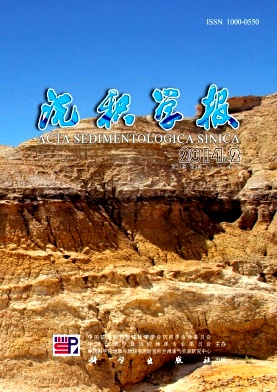Distribution of Sandbodies in a Sequence Stratigraphic Framework in Lower Cretaceous of Beier Depression
- Publish Date: 2014-04-10
-
Key words:
- sequence stratigraphy /
- depositional system /
- lowstand system tracts sandbodies /
- fault-accommodation zones /
- Beier depression
Abstract: Hailaer Basin, featured by frequent structural movement, simple depositional cycle, multi-and near-sources, coarse clastic, narrow-sedimentary facies and more fans, is Mesozoic Early Cretaceous fault depressed lacustrine basin developed on the Hercynian geosyncline folded base in northeast China. After its formation, Hailaer Basin had gone through three tectonic phases, including rift initiation, rift extension and post-rift episodes, and each phase has its own depositional system. Based on the theory of sequence stratigraphy and used all data such as seismic, well log, core analysis and palaeophyte, this paper focuses on sandbodies distribution in a sequence stratigraphic framework in Lower Cretaceous of Beier depression. Studies show that there are three second-order sequence correspond to three tectonic phases, including rift initiation sequence SQⅠ(Tongbomiao group K1t), rift extension sequence SQⅡ(Nantun group K1n) as well as post- rift sequence SQⅢ(Damoguaihe group K1d), and six third-order sequence including SQA(Tongbomiao Group K1t), SQB(Nanyi member K1n1), SQC(Nan’er member K1n2), SQD(Dayi member K1d1), SQE(Daer member K1d2) and SQF(Yimin Group K1y) as well as fourteen systems tracts. In the third-order sequence stratigraphic framework, the spatial distributions and sedimentary assemblages of depositional system are varying significantly in different depositional stage. In the depositional period of sequence SQA(formed in the rift initiation episode), which developed the coarse clastic sedimentary assemblage as alluvial fan and subaqueous fan. During the depositing period of sequence SQB~SQC (formed in the rift extension episode), which developed the sedimentary assemblage as subaqueous fan, turbidite fan, fan delta and semi-deep. While during the depositing period of sequence SQD ~SQF(formed in post-rift episode), which developed the sedimentary assemblage as delta, shore-shallow lacustrine and semi-deep, as well as fluvial and paludal facies. Lowstand system tracts sandbodies were mostly distributed in rift extension sequence SQⅡwith favorable reservoir conditions. Meanwhile, the above thick claystone in transgressive and highstand system tracts act as cap rocks at the same time. So they can firm favorable reservoir-seal assemblage and lithologic-stratigraphic traps. Studies also show that lowstand system tracts sandbodies are mainly distributed in the depositing period of sequence SQA~SQC, while few in SQD~SQF. The main types of sandbodies are braided river channel, subaqueous fan, turbidite fan, fan delta and so on, which are featured by muti-layers with thick single layers. Controlled by multi sources, lowstand system tracts sandbodies had superposed and jointed in most of the depression.The sandbodies controlling factors are very complicate in these kinds of basins. From the aspects of analyzing the function of structure controlling depositional system, synsedimentary structures often play an important part in sandbodies deposition and its distribution. Especially, lowstand system tracts sandbodies, of which spatial distribution are mainly influenced by episodic tectonic movements and the types of structural slope break zone formed by many different level and types of faults, is the most important reservoirs for lithologic traps. The formation and distribution of lowstand system tracts sandbodies is mainly controlled by the types of structural slope break zone vertically. Three types of structural slope break zone developed on the basin margin, resulting in three types of depositional systems. Nearshore subaqueous fan system resulted from faulted scarp type break in-slope; slope fans system developed on faulted terrace type break in-slope; fan-deltas and sub-lake fan system developed on steep slope type break in-slope. While in plane, sandbodies, featured by thin thickness, small range of extension, a rapid horizontal variation and along fault strike in bands or apron shape, are controlled by the style of faulted slope-break zone. Especially, the shape and scale of sandbodies is controlled by fault-accommodation zones. Four basic types fault-accommodation zones including fault-bend, fault-connect, fault-valley and fault-intersect, and six complex types fault-accommodation zones including fault-bend and fault-intersect, fault-bend and fault-connect, fault-bend and fault-valley, fault-connect and fault-intersect, fault-connect and fault-valley, and fault-intersect and fault-valley are concluded by genesis. As a result, different kinds of sandbodies tend to be superposed and jointed in middle sag, which are the material basis of lithologic-stratigraphic traps-forming. In system tracts sequence stratigraphy framework, controlled by fault-accommodation zones and their combinations, sandbodies have various scales and shapes and show striped distribution along fault strike in Beier depression. During the depositing period of lowstand system tracts of sequence SQB, sedimentary facies of this area is shore-shallow lacustrine to semi-deep lake sediments. The lowstand system tracts of Nanyi member mainly develop fan delta, subaqueous fan and turbidite fan. Especially, in southwestern Beixi sub-depression, fault-intersect type mostly developed in steep slope for fault terrace, while fault-bend and fault-connect types in gentle slope for many consequent faults. For small deposition area and shallow water, this area has many kinds of lowstand system tracts sandbodies, which are controlled by fault-accommodation zones and show striped distribution along the long axis direction of Beier depression.
| Citation: | Distribution of Sandbodies in a Sequence Stratigraphic Framework in Lower Cretaceous of Beier Depression[J]. Acta Sedimentologica Sinica, 2014, 32(2): 334-342. |






 DownLoad:
DownLoad: